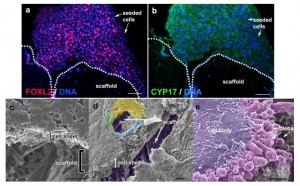Printed Ovary Could Restore Fertility

Latest News
May 19, 2016
Northwestern University researchers have successfully printed and implanted a functioning prosthetic ovary in lab mice.
The team at Northwestern created the prosthesis using a 3D printer. Mice that had previously had their ovaries removed were able to use the implant to bear live young. The technology could potentially be used to restore fertility in women who have been treated for cancer or other conditions.
The researchers, who work in the Woodruff Lab and the Shah Tissue Engineering and Additive Manufacturing Lab at the Feinberg School of Medicine, presented their findings at ENDO 2016, the Endocrine Society’s annual meeting, in April.
The 3D-printed gelatin scaffold supports hormone-producing cells and immature egg cells (oocytes). The scaffold includes a criss-crossing strut design that allows the cells to anchor at multiple points. The scaffolds were then seeded with ovarian follicles (which contain an oocyte and supportive cells) to make the prosthetic.
The researchers used an EnvisionTEC 3D bioplotter to print the scaffolds.
The mice had their ovaries replaced with the structures. The test animals were able to ovulate, give birth and nurse their offspring. The structure also supported blood vessel growth without any external stimulation.
The implant also restored the female hormone cycle in the mice, which means that the procedure could potentially improve hormone cycling in women with reduced ovarian function.
“We developed this implant with downstream human applications in mind, as it is made through a scalable 3D printing method, using a material already used in humans,” said lead study author Monica Laronda. “We hope to one day restore fertility and hormone function in women who suffer from the side effects of cancer treatments or who were born with reduced ovarian function.”
The research team will work with the Ann and Robert H. Lurie Children’s Hospital of Chicago to further explore how the technology can work with humans. One of the primary applications could be pediatric cancer patients.
“We already isolate and preserve ovarian tissue in pediatric patients at Lurie Children’s who are going to undergo treatment that would destroy these cells,” Monica Laronda told The Daily Northwestern. “We’re hoping that we’ll have those methods ready for them once they’re old enough and before they lose all their sex hormone function.”
Source: EurekAlert!
Subscribe to our FREE magazine, FREE email newsletters or both!
Latest News
About the Author
Brian Albright is the editorial director of Digital Engineering. Contact him at [email protected].
Follow DE





